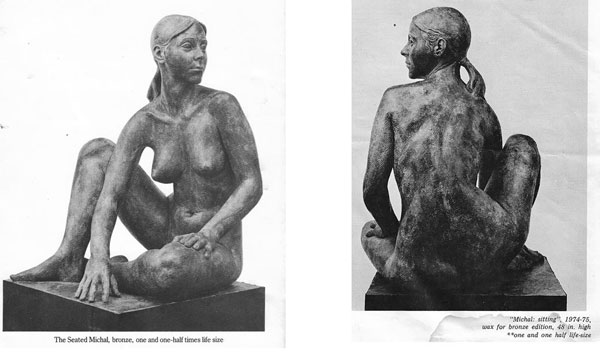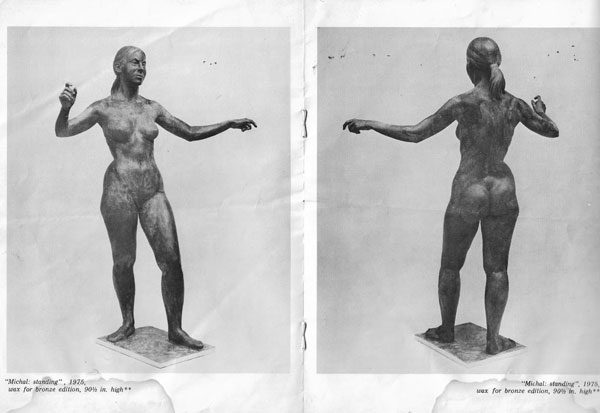
I was a student at Queens College, working for my BFA, when I encountered Richard McDermott Miller (who was known as the Figure Sculptor of Soho) and took his class in life sculpture. He was a good, fair teacher. When I heard he was looking for a model, I inquired, and he hired me. I had been doing a lot of that kind of work at the school to pay my rent, and was considered one of the better models, as I was able to come up with and hold, interesting poses.
I worked for him between 1974-75. During that time, he produced two one and a half times life-sized statues of me, in wax and bronze. (Keep in mind that I was just over 5’2,” making the standing figure 7.5 feet tall) He went on (after I had ceased to work for him) to create works of art based on those two poses. One was a torso that was so large he included a door, so that one could go inside and look at the armature.
Miller had a studio at 53 Mercer street, a three story Dutch building between Broome and Grand. He had moved to Soho in the 60’s and I believe he owned it, but he only used two floors, the ground and the basement. It was an unprepossessing façade, a building you could easily walk past without a thought. You would never guess what was inside.
The first time I walked into his workspace I was bowled over…. He made very large sculptures of women, and he enjoyed athletic poses. So as I walked into the very long, high-ceilinged loft toward this rather diminutive man at the end, I was surrounded by dimly lit monumental statues of women crouching, leaping or twisting on either side. It was rather like a Marvel comic book come to life! At the end of this walk, there was Miller. His actual work area was well lit, and he had a space heater for me, to prevent me from getting too cold.
Miller was a very methodical, practical man. His studio contained machinery of his own design that was required for his work, such as heavy chains and pulleys for lifting and hoisting the massive bronzes from one location to another. At the time, I believe the front of the first floor had a pull-down metal grate over huge doors, and he moved his statues in and out at street level that way.
The first day, he had me pose on a rotating platform while a camera took photos of the pose every 15 degrees so that he could look at it from all angles and determine if it would hold up from all views. The first day, I came up with several poses and after reviewing them, he decided on the seated one.

The standing pose was more something that he had been wanting to do, as he made a study of statues from ancient to modern times, and felt that there was a great deal of variation to be found in them. He gave me rods to hold onto so that I could keep my arms up in the proper position for long periods of time, and he marked both my foot positions and my hip alignment on the pedestal so that I could reproduce the exact pose every time. He also worked with calipers, so that the proportions from life to one and a half times that, would translate precisely.
He would make the first “draft” of the pose in miniature, in wax. After that, he would start work on the big wax version which would eventually be cast in Bronze. He had the casting done at the Modern Art Foundry in Long Island City, and he invited me to visit there and check out the process.
Getting off work was cool because I was in Soho, and I could go back home, or to an opening, or to Magoo’s, a bar just below Canal street that was frequented by artists because Tommy Magoo would take art in exchange for food. So there was always a good crowd there, playing pool, drinking, chowing down and gabbing about art. There was a good jukebox, too. Needless to say, the walls of the place were covered with art. (At the time Soho pretty much closed up at night, so the only other places that folks could gather at was the Spring Street Bar, Broome Street Bar and of course, Fanelli’s.) But the vibe at Magoo’s was definitely ART. I met a lot of the artists from the scene there, and even sketched a few of them. (Regrettably nothing I kept.) I heard that after Tommy died, the bar was dismantled and sent to Japan, but who knows? Anyway, it was a great place to hang out, if you could tolerate the cigarette smoke. The artists who hung out there were mostly people from all over the States, and it was funny that when I would enter and sit at my sister Vered’s table, she would introduce me to these people as “my sister from out of town.” Then someone would turn to me with great interest and say something like “Really? Where y’all from?” and I would answer “Flushing.”
That’s right, I lived in Flushing at the time, (moved to Soho later) so getting to Soho was a bus and two trains (the #12 bus and #7 and R trains to Canal street ). But Soho was very much the place where I worked and socialized, and I thought it was pretty hilarious that I was from “out of town.” But that does give the picture of how much Soho was the center of the art world for so many people that the outer boroughs might just as well have been the outback. How times have changed!
After a bit of hanging out, sometimes we would be invited to see someone’s work back at their loft. Or it might even be just going to see how someone had finally finished their floors! Remember a lot of the lofts had awfully old wooden floors and so folks would take them down and refinish them and when you have a loft that is thousands of square feet, that is a BIG job, and you want to show it off. I sometimes think of how hard those artists worked on those floors, just to be eventually evicted, and have someone else enjoy walking on them who never knew what went into them.
It was an interesting contrast to my daytime job working for a man who was dedicated to resoundingly figurative work, and I kept the two worlds strictly separate. Here was Soho brimming with abstract and conceptual artists, and there was this man who was a true pioneer of the neighborhood but a dedicated figurist. He had carousels filled with slides he had taken of Venus statues throughout history, and he turned me on to sculptors I was not familiar with like Maillol (whom I really liked) and St. Gaudens. I learned a lot.
I don’t think that Miller was trying to stylize anything, although his work was definitely personal and sincere. He was in love with the female form, and when you look at his surfaces you clearly see the marks of the modeling tool he used on the wax. Every contour is faithfully and lovingly caressed with a thousand little marks. It is realistic, but intensely observed. He once said to me “you are Venus” and I laughed and told him he was the only man on earth who could say that and get away with it.
